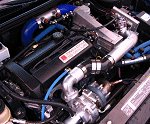

|
Street Class Unlimited Class
DOHC SOHC Ion Updated 1/05 For the most recent list of the fastest five cars click here. |
Ian's Turbo F.A.Q. - Page 4by:Qksl2Should I get a wastegate? Well a wastegate is on every turbo charged vehicle, whether it is internal or external; they all have 'em. Wastegates are what regulate the amount of boost that your turbo puts out. When a certain pressure or PSI is met it bleeds the exhaust off and doesn't allow it to go into the charge pipe. Basically exhaust bypasses the turbine wheel to regulate the speed, which regulates the boost. I'm amazed at how precise they are at doing so, all things considered. Do I need a 3" exhaust? Again, depending on boost level you may gain little more than noise with a larger exhaust. A 3" straight through exhaust is ideal for making more boost faster, but if you are limiting boost to under 10 PSI, a 3" turbo exhaust isn't necessary. You can easily run a standard straight through cat-back exhaust at 8 PSI without too much loss, and it will be considerably quieter. This applies to supercharged cars as well, but supercharged cars can run even higher boost with less losses on a standard cat-back exhaust. Mostly because supercharged cars will sound like ass if you go too big on the exhaust. Turbo cars will sound great, as the turbine wheel smooths out the exhaust a lot. Recommended Clutches The ACT Street clutch is recommended for up to 12 PSI. If you plan on running anything higher than that, I would recommend you go with the 6 puck. Better safe than sorry with the clutch. The 6 puck WILL chatter, but generally it is not too bad once broken in. The ACT street clutch is as smooth as butter, and it is the only aftermarket clutch right now that uses a pressure plate that is not a modified factory unit. The centerforce, in my experience, will last all of 30 minutes under boost; the Clutch Masters wears out extremely fast; and the SPEC will induce serious amounts of crankwalk. I know this by experience not a misunder estimated strategery guestimation! Recommended Gauges 1. Boost Gauge Another recommended item, that I would get, is a shift light. Even
though it's not really a gauge, but rather a simple, small shift
light that can help you be more consistent. As well as prevent you
from hitting the rev limiter, which could save you from an expensive
mess. Hitting the rev limiter in a vehicle that cuts fuel while
under full boost will be disastrous! Stay AWAY from the A/F Gauges The minimum would be boost and a/f gauges. Any boost gauge will
work. For an a/f gauge, I like the Halmeter in combination with
an O2 sensor from an 89 Escort. It has 3 wires instead of one, so
it's heated. The Halmeter is a 30 LED a/f gauge that is New developments by certain members of Turbosaturns.net have recently shown the reliability, cost-effectiveness, and importance of a wideband O2 (WBO2) sensor in combination with boost. Using a WBO2 sensor along with the MS unit for fuel control is your definitive solution for tuning! A narrow band O2 sensor like that which comes in 99% of the cars today is accurate, but only in the 14.5-14.9 range of a/f ratio. For running boost, you want to tune much lower than that, for a safer, richer condition. That being said, a narrow band O2 sensor is nearly useless for actual tuning as it is very far out of it's accuracy range while under boost. All the way rich on an autometer gauge could be terribly lean. A WBO2 sensor, on the other hand, has a 0-5 volt output (as compared to 0-1 volt) which allows for better resolution. Not only does the sensor read extremely accurately across an enormous range of a/f ratios (10.0-19.0), but it also gives one feedback that is precise. I will not boost another Saturn without having such a device! It is a very important part of any turbo system, and should NOT be overlooked! Info: DIY-WB Project (~$200US for all the parts, needs to be assembled) Techedge WBO2 ($?) AEM Wideband UEGO Controller (~$350US) Information Board: http://turbosaturns.net/forum/viewforum.php?f=16 (BROKEN) Boost Controller An electronic boost controller is very nice. It allows you to run minimal boost for around town driving, and then bump it up for the occasional street encounter or drag race. However, a manual controller will work. Be careful, though, as manual boost controllers are more prone to boost spiking. As far as which controller, it is mostly preference. I really like my GReddy PRofec A, though the PRofec B is cheaper and simpler but works well. The AVC-R is quite complex and has some nice features, but it costs quite a bit more. Where do I tap into wire up my {insert any name turbo timer here} turbo timer? Mike did a great turbo timer install article. Please look here: What size socket do I need to remove the stock oil galley plug? An 8mm allen socket. The oil galley plug is accessible by using
a ½ inch drive - 8mm allen socket, an universal joint,
and a long extension running up between the number 2 and 3 intake
manifold runners. Put a breaker bar on top and break it loose from
above the motor. It will make a nasty farting/cracking noise, and
you'll think you have broke something, but you didn't. The top picture
here, http://qksltwo.com/part2.html,
shows exactly where to source the oil feed. The size adapter you'll
need is an M16 x 1.5 to a -4AN fitting. These are available from
JEGS or Summit and whatnot. For the return line, you'll want to
use a -10AN or larger stainless braided line. It's very important
that it's downhill all the way to the pan. It needs to enter the
pan ABOVE the oil level. You'll need to pull the oil pan and have
a fitting welded on. A new oil pan from Saturn is only $65. Oil Feed Line The feed line should be a -4 an braided stainless line. Earl's
lines are available through Summit Racing. The return line should
be a minimum of -8 an, or even -10 an. It should have no kinks and
be downhill all the way. You'll have to have a turbo return line
fitting welded into your oil pan. Make sure it is above the level
of the oil! Here
is a picture of where on the block you tap for an oil feed line. How Turbos Work: Ok, to begin & hellp; first a little physics - The Ideal Gas Law. Temperature, pressure, and volume are all directly related. If you take a certain amount of gas and compress it, both temperature and pressure go up (this is why you MUST use an intercooler, but more on that later). If you give it space to expand, pressure and temperature go down, equally opposite. Increase the temperature, and the pressure goes up (in an enclosed space), or the volume goes up (it expands). Lastly, gases always want to flow from where there is higher pressure to where there is lower pressure. Gases get stressed out too, basically, like you know, the week of finals, when your girlfriend is mad and all that jazz… The way our inefficient piston engines do "work" (if you can call what our underachieving motors do that. lol!) is by making gas expand in an enclosed space (the combustion chamber; apparently Saturn hired a bunch of 6 year olds, gave them coloring books and crayons, and said, "make a combustion chamber!") which pushes the piston down (so long as you don’t throw a rod) and turns the crank. In short, kaboom, piston pushes down, turns the crank…next detonation revolution follows. A lot of heat is created in this process, but typically that is all wasted out through the exhaust. Remember, heat is energy in its own form, we aren’t racist here. It's just not in the cylinder long enough to transfer all that heat into mechanical energy, and it's not practical to make cylinders "tall" enough to extract every last bit of work from that hot expanding gas. So you want to use that energy, eh? Ah & the turbocharger. This lil munchkin uses that hot exhaust energy that would otherwise go unused and wasted in a n/a (not applicable) setup to turn a turbine. This turbine is connected to a compressor section which compresses air. Air has a certain specific energy per volume. With boost, you can fundamentally fit an enormous volume of air into the same size area; thus, you have all the potential energy of that huge volume of air going in at the same speed and efficiency as a like volume of air with less than half the energy(that's the technical way of explaining it, Leyva!). Now, here comes the whining of the supercharged, naturally aspirated, and others who don't have a turbo. "But the turbo heats up the air because it's connected to the exhaust." Bah! No, it doesn't. It heats up because it's being compressed, just like a supercharger or any other compressed air. How much it gets heated up is largely a factor of the compressor's efficiency, and turbos have the highest efficiency of any type of forced induction and by a strong margin. This is why we intercool these setups because ,no matter how efficient your turbo is, boosting is heating. It is NOT heating up in any significant manner due to heat transfer from the exhaust. Air chopping by a T-Too-Small (T25) would heat the air (by overspinning) 100X's more than the heat "transfer" from the hot turbine section. This is the closest thing to a "free lunch" that you will find in engineering because you are taking heat (energy) that would otherwise be wasted and getting usable work out of it with almost no trade offs. You gain a little complexity and added manufacturing costs, but there is no real performance hit from adding a turbo. Basically, it's a headache and don't even think about it unless you plan on getting under the car and wrenching yourself. |
|



